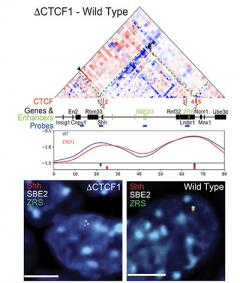Probing TADs in development
Alteration of TAD boundaries does not prevent Shh gene function or impair development: September 2019

Within the nucleus of cells, DNA is organised and folded up in various non-random ways. One of these levels of three dimensional organisation is termed topologically associated domains (TADs) which are classified as regions of the DNA that preferentially interact with each another as opposed to with other DNA sequences. Disruption of TADs can affect the regulation of genes and lead to disease.
Shh is a critical gene required during embryonic development and is needed for proper patterning of a number of developing tissues, including limbs and the central nervous system. To ensure Shh is switched on correctly at the right time and place during the development of these tissues a number of DNA sequences, called enhancers, are required.
Organisation of DNA into TADs has been suggested to be important for helping these enhancers function correctly to control expression of the right gene, such as Shh, during development. Researchers from the MRC Human Genetics Unit manipulated the Shh TAD by removing DNA sequences within the TAD and at the TAD boundaries.
Using microscopy and sequencing-based approaches to analyse DNA organisation, the scientists found that the Shh TAD structure and DNA folding were significantly altered following deletion of TAD boundary sequences. However, the Shh gene was still able to function normally and mouse embryos with these TAD boundary sequence deletions still developed normally. These findings suggest TADs may not always be critical for ensuring genes are controlled properly during embryonic development.
Links
Original article: https://doi.org/10.1242/dev.179523
Hill research group

